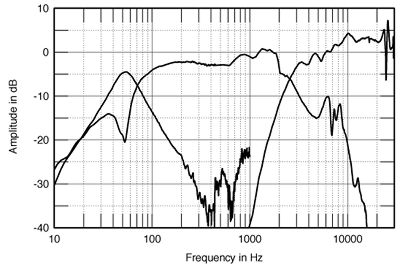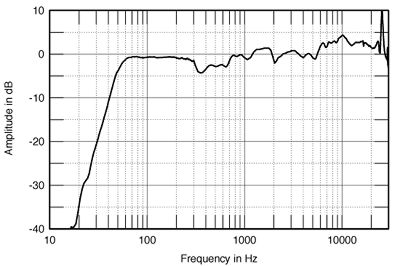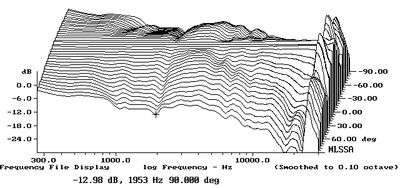| Columns Retired Columns & Blogs |
Kirksaeter Silverline 60 loudspeaker Measurements
Sidebar 3: Measurements
The Kirksaeter Silverline 60 played surprising loud for such a small speaker, its voltage sensitivity coming in at 89dB(B)/2.83V/m. However, this will be due, at least in part, to its non-flat frequency response (see later). Its plot of impedance magnitude and frequency (fig.1) indicated that it will be a fairly easy load for the amplifier to drive. While the minimum magnitude was 4.6 ohms at 245Hz, the speaker's impedance remained above 6 ohms over much of the audioband, and the electrical phase angle was significant only at frequencies at which the magnitude was also high, which will mitigate any drive problems.

Fig.1 Kirksaeter Silverline 60, electrical impedance (solid) and phase (dashed). (2 ohms/vertical div.)
Glitches in the impedance traces are evident at 350Hz and 27kHz. The latter is due to the tweeter's ultrasonic dome resonance and should be inconsequential. The lower-frequency glitch, however, is due to some kind of panel resonance and will be more serious in its effect. And when I examined the vibrational behavior of the 60's cabinet, I did find a very strong vibrational mode on all surfaces (fig.2). However, at 402Hz, this is a little higher in frequency than the impedance glitch, which remains a puzzle.

Fig.2 Kirksaeter Silverline 60, cumulative spectral-decay plot calculated from the output of an accelerometer fastened to the cabinet's back panel. (MLS driving voltage to speaker, 7.55V; measurement bandwidth, 2kHz.)
The saddle at 50Hz in the impedance-magnitude trace at 50Hz indicates the tuning frequency of the rear-facing port. Confirming this, it is also the frequency of the minimum-motion point in the woofer's output (fig.3) and that of the peak of the port's bandpass. There is some raggedness apparent in the port's output between 500Hz and 1kHz, but it is well down in level. The crossover from the woofer to the tweeter appears to lie at around 2.5kHz. Note, however, that the woofer's on-axis response rises toward the top of its passband, and that the tweeter appears to be balanced 3dB too high in level.

Fig.3 Kirksaeter Silverline 60, acoustic crossover on tweeter axis at 50", corrected for microphone response, with the nearfield woofer and port responses plotted below 300Hz and 1kHz, respectively.
The result is apparent in fig.4, the 60's quasi-anechoic response averaged across a 30 degrees horizontal window centered on the tweeter axis, which slopes up by 5dB or so from 500Hz to 10kHz. Yes, Brian Damkroger noted that the Kirksaeter made vocals sound a little lightened, and that cymbals decayed "into a metallic hiss rather than blooming into cascading waves of overtones"—both of which correlate with the shape of the curve seen in fig.4. But I would have expected the treble rise to be more apparent than BD found, particularly as the speaker's low frequencies lack the usual minimonitor hump in the upper bass to balance its top octaves. Certainly in my own auditioning of the 60, I was aware of there being too much HF energy apparent. At the other end of the spectrum, BD noted that the speaker's bass rolled off below 50-60Hz, exactly as shown in fig.4, which is good low-frequency extension for a small, sensitive speaker.

Fig.4 Kirksaeter Silverline 60, anechoic response on tweeter axis at 50", averaged across 30 degrees horizontal window and corrected for microphone response, with the complex sum of the nearfield woofer and port responses plotted below 300Hz.
The Kirksaeter's lateral dispersion (fig.5) reveals the woofer to get more directional at the top of its passband than I would have expected from its small radiating diameter, which results in a degree of "flare" at the bottom of the tweeter's passband. But the tweeter itself becomes directional an octave or so lower than is usual, meaning that the room's reverberant field will lack energy in the top two octaves, which will in turn work against the on-axis excess. In fact, BD noted that the 60 sounded a bit rolled-off on top! In the vertical plane (fig.6), broad suckouts develop in the crossover region if the listener sits with his ears much above or below the tweeter axis, and the tweeter's limited HF dispersion can again be seen.

Fig.5 Kirksaeter Silverline 60, lateral response family at 50", normalized to response on tweeter axis, from back to front: differences in response 90 degrees-5 degrees off axis, reference response, differences in response 5 degrees-90 degrees off axis.

Fig.6 Kirksaeter Silverline 60, vertical response family at 50", normalized to response on tweeter axis, from back to front: differences in response 45 degrees-5 degrees above axis, reference response, differences in response 5 degrees-45 degrees below axis.
The 60's step response on the tweeter axis (fig.7) indicates that both drive-units are connected in positive acoustic polarity, with the tweeter's output leading the woofer's by a quarter of a millisecond. The cumulative spectral-decay plot (fig.8) indicates a very clean decay throughout almost the entire midrange and treble, which might well mitigate the audibility of the tilted-up response. Note, however, that a ridge of delayed energy just below 2kHz is associated with a distinct step in the on-axis response. This will add a degree of stridency at high playback levels—BD did comment on how "the 60 could begin to sound confused and a bit strained during loud, complex orchestral crescendos"—and is associated with a slightly nasal coloration, in my experience.

Fig.7 Kirksaeter Silverline 60, step response on tweeter axis at 50" (5ms time window, 30kHz bandwidth).

Fig.8 Kirksaeter Silverline 60, cumulative spectral-decay plot at 50" (0.15ms risetime).
Overall, these measurements of the Kirksaeter Silverline 60 indicate a balance that will work better in some circumstances than in others. In a small, barely furnished room with cheap solid-state amplification, the sound will be too bright. But in a larger room with better-matched electronics, such as BD used for most of his review, the 60's tonal aberrations might well disappear in favor of a superb presentation of detail, the trick pulled off by the ProAc Tablette of two decades ago.—John Atkinson
- Log in or register to post comments




































